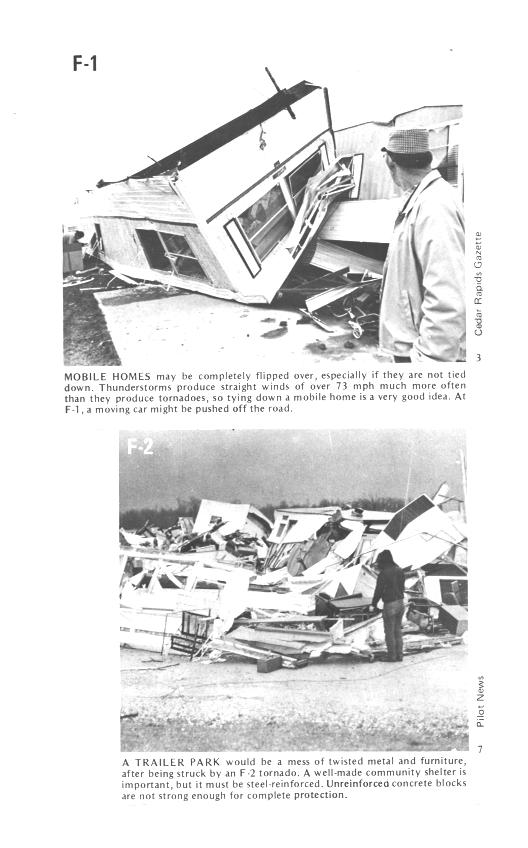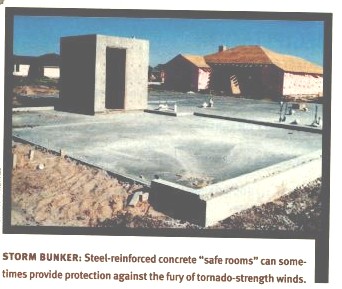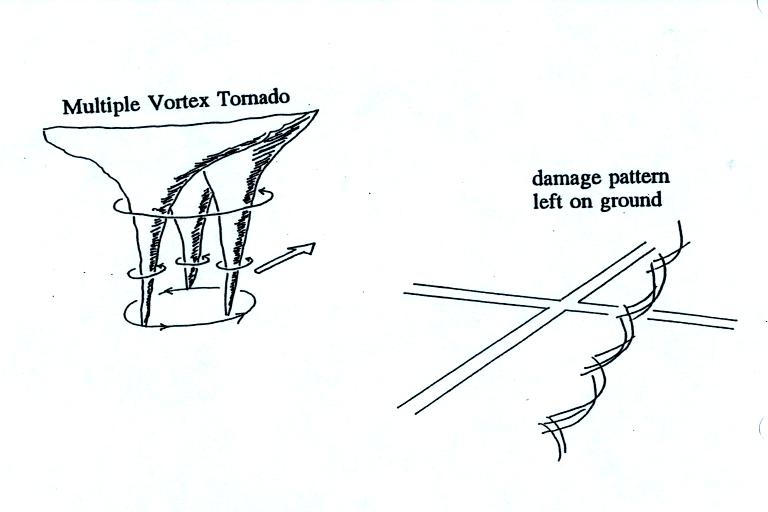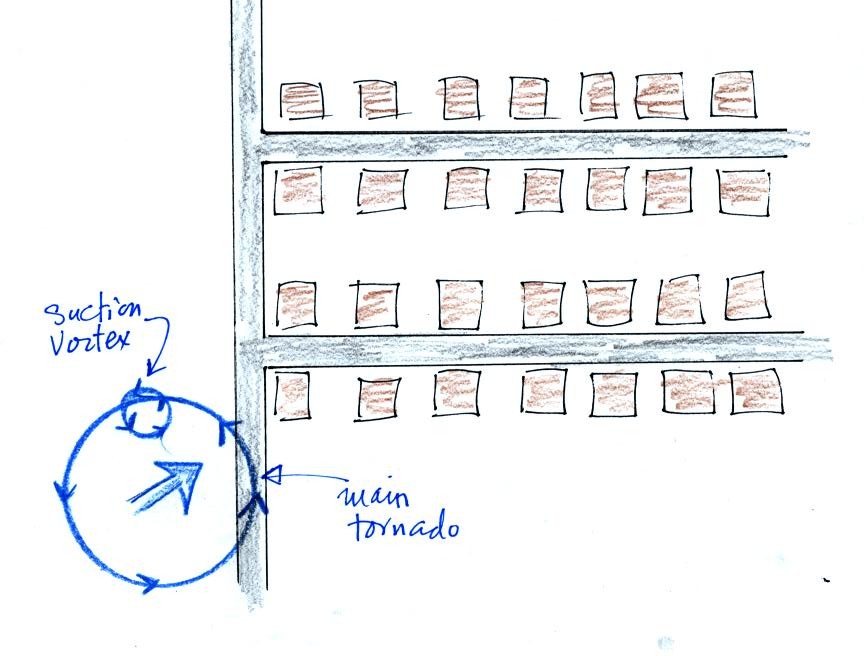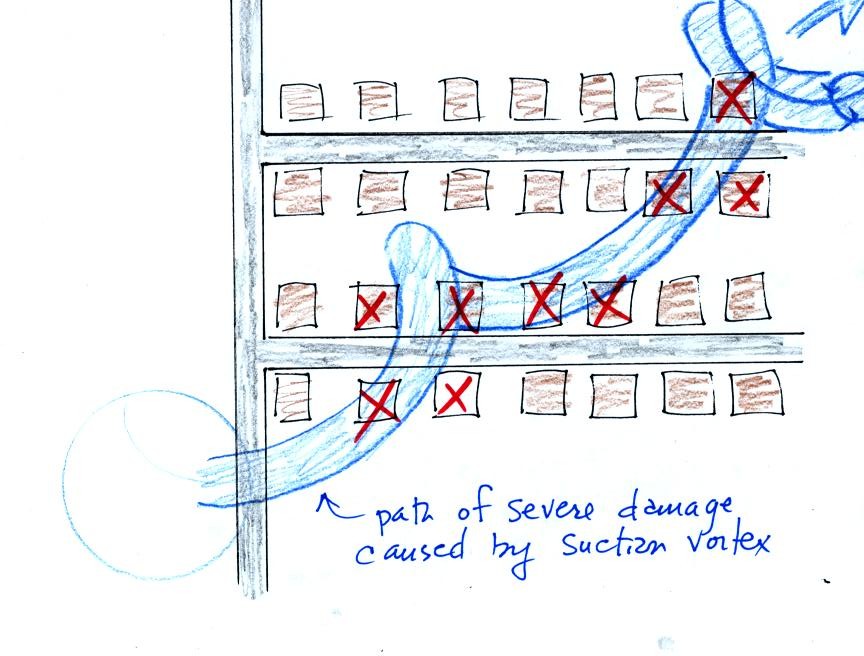Most of
the class period today was devoted to lightning. Here's a little
introductory information that wasn't covered in class.
Lightning kills just under 100 people every year in the United States (more than tornadoes or hurricanes but less than flooding, summer heat and winter cold) and is the cause of about 30% of all power outages. In the western United States, lightning starts about half of all forest fires.
Lighning is most commonly produced by thunderstorms (it has also be observed in dust storms and volcanic eruptions such as the one that occurred earlier this year in Iceland). Lightning caused fires are a particular problem at the beginning of the thunderstorm season in Arizona. At this time the air underneath thunderstorms is still relatively dry. Rain falling from a thunderstorm will often evaporate before reaching the ground. Lightning then strikes dry ground, starts a fire, and there isn't any rain to put out or at least slow the spread of the fire. This is so called dry lightning.
Lightning kills just under 100 people every year in the United States (more than tornadoes or hurricanes but less than flooding, summer heat and winter cold) and is the cause of about 30% of all power outages. In the western United States, lightning starts about half of all forest fires.
Lighning is most commonly produced by thunderstorms (it has also be observed in dust storms and volcanic eruptions such as the one that occurred earlier this year in Iceland). Lightning caused fires are a particular problem at the beginning of the thunderstorm season in Arizona. At this time the air underneath thunderstorms is still relatively dry. Rain falling from a thunderstorm will often evaporate before reaching the ground. Lightning then strikes dry ground, starts a fire, and there isn't any rain to put out or at least slow the spread of the fire. This is so called dry lightning.

A typical summer thunderstorm in
Tucson is shown in the
figure
above. Even on the hottest day in Tucson in the summer
a large part of the middle of the cloud is found at below
freezing temperatures and contains a mixture of super cooled water
droplets and ice crystals. This is where precipitation forms and
is also where electrical
charge is created. Doesn't it seem a little unusual that
electricity can be created in such a cold and wet environment?
Collisions between precipitation particles produce the electrical charge needed for lightning. When temperatures are colder than -15 C, graupel becomes negatively charged after colliding with a snow crystal. The snow crystal is positively charged and is carried up toward the top of the cloud by the updraft winds. At temperature warmer than -15 (but still below freezing), the polarities are reversed. Large positive and negative charge centers begin to build up inside the cloud. When the electrical attrative forces between these charge centers gets high enough lightning occurs. Most lightning (2/3 rds) stays inside the cloud and travels between the main positive charge center near the top of the cloud and a large layer of negative charge in the middle of the cloud; this is intracloud lightning. About 1/3 rd of all lightning flashes strike the ground. These are called cloud-to-ground discharges (actually negative cloud-to- ground lightning). We spent most of the rest of the class learning about this particular type of lightning.
Collisions between precipitation particles produce the electrical charge needed for lightning. When temperatures are colder than -15 C, graupel becomes negatively charged after colliding with a snow crystal. The snow crystal is positively charged and is carried up toward the top of the cloud by the updraft winds. At temperature warmer than -15 (but still below freezing), the polarities are reversed. Large positive and negative charge centers begin to build up inside the cloud. When the electrical attrative forces between these charge centers gets high enough lightning occurs. Most lightning (2/3 rds) stays inside the cloud and travels between the main positive charge center near the top of the cloud and a large layer of negative charge in the middle of the cloud; this is intracloud lightning. About 1/3 rd of all lightning flashes strike the ground. These are called cloud-to-ground discharges (actually negative cloud-to- ground lightning). We spent most of the rest of the class learning about this particular type of lightning.

A couple of interesting things that
can happen at the ground when
the
electrical forces get high enough. Attraction between positive
charge in the ground and the layer of negative charge in the cloud can
become strong enough that a person's hair will literally stand on
end (see photo below). This is incidentally
a dangerous situation to be in as lightning might be about to
strike. St.
Elmo's
fire
is a faint
electrical discharge that sometimes develops at the tops of elevated
objects during thundestorms. It was first observed coming from
the tall masts of sailing ships at sea (St. Elmo is the patron saint of
sailors).
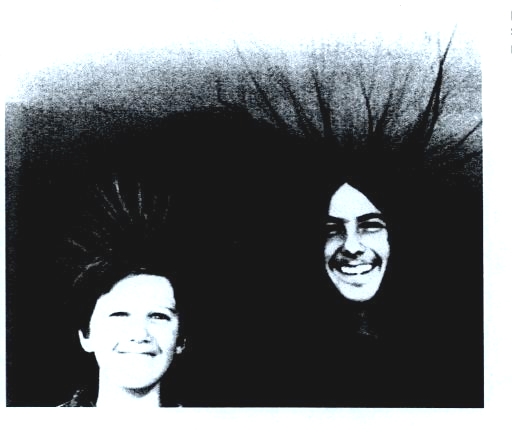
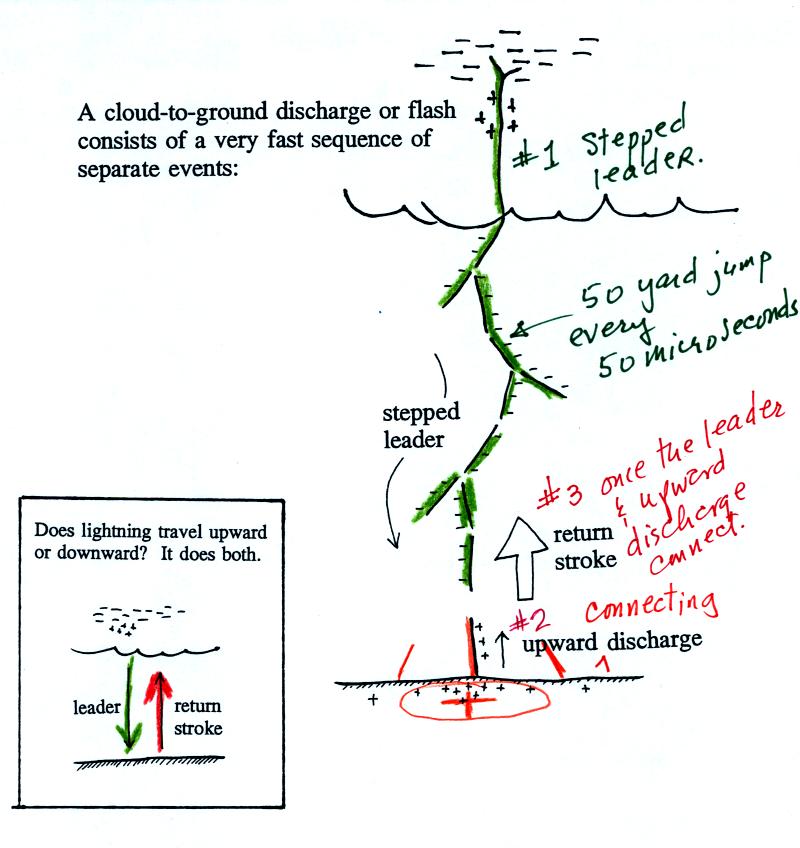
Most cloud to ground discharges
begin with a
negatively-charged
downward-moving stepped leader. A developoing channel makes its
way down toward the
cloud in 50 m jumps that occur every 50 millionths of a second or
so. Every jump produces a short flash of light (think of a strobe
light dropped from an airplane that flashes periodically as it falls
toward the ground). The sketch below shows what you'd see if you
were able to photograph the stepped leader on moving film. Every
50 microseconds or so you'd get a new picture of a slightly longer
channel displaced slightly on the film.
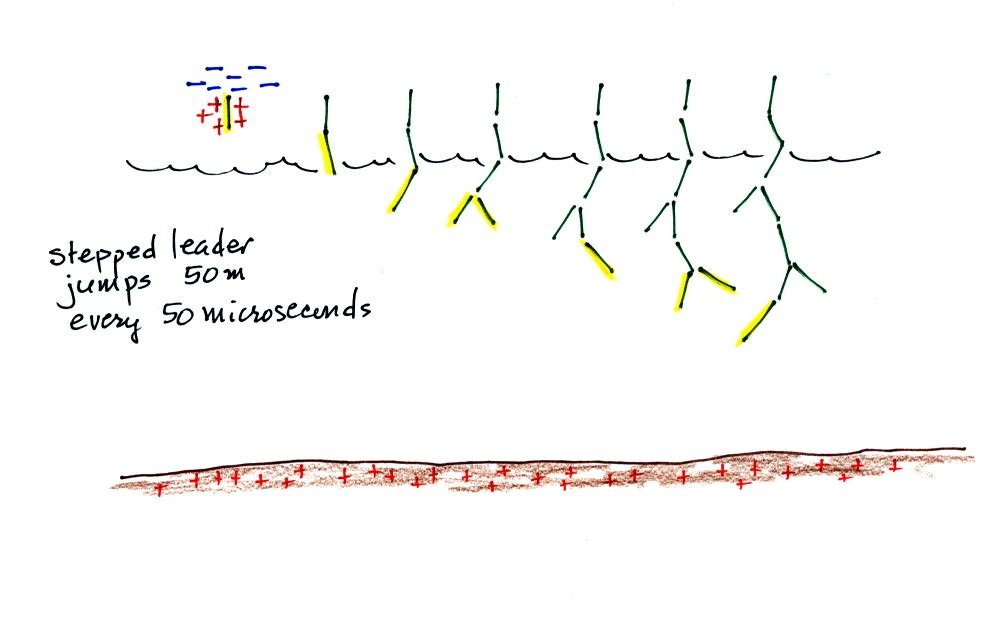

As the leader channel approaches
the ground strong electrical attraction develops between negative
charge in the leader channel and positive charge on the surface of the
ground. Several positively charged sparks develop and move
upward toward the stepped leader. One of these will intercept the
stepped leader and close the connection between negative charge in the
cloud and positive charge on the ground.

Lightning
rods take advantage of
this principle.

Houses
with
and without lightning rods
are
shown
above. When lightning strikes the house without a lightning rod
the powerful return stroke travels into the house destroying the TV and
possibly starting the house on fire.
A lightning rod is supposed to intercept the stepped leader and safely carry the lightning current around the house and into the ground.
The connection between the stepped leader and the upward discharge creates a "short circuit" between the charge in the cloud and the charge in the ground.
A lightning rod is supposed to intercept the stepped leader and safely carry the lightning current around the house and into the ground.
The connection between the stepped leader and the upward discharge creates a "short circuit" between the charge in the cloud and the charge in the ground.
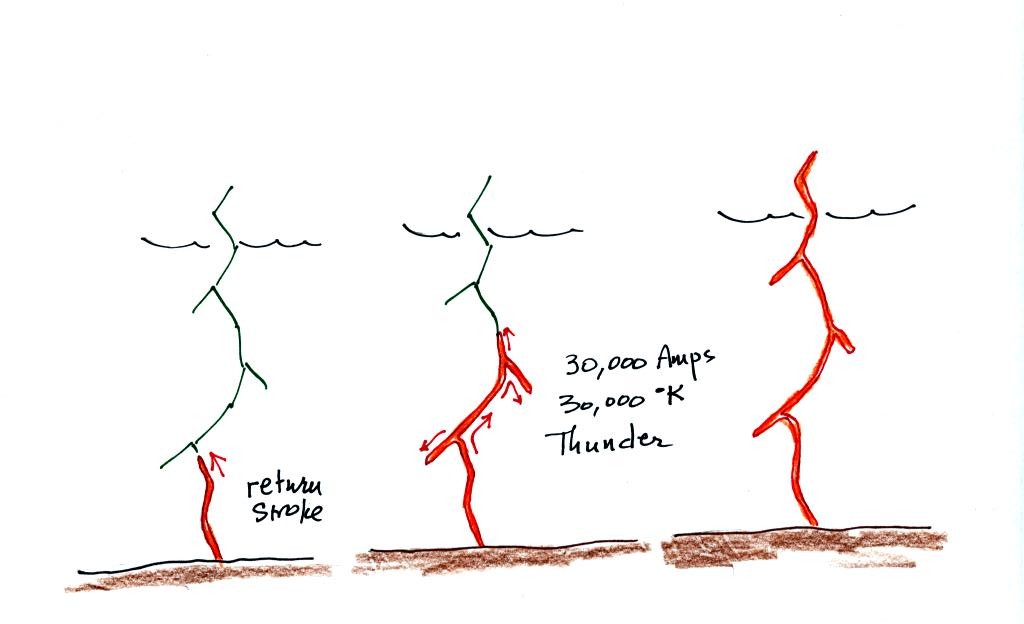
The figure below shows what we've learned so far in simplified form
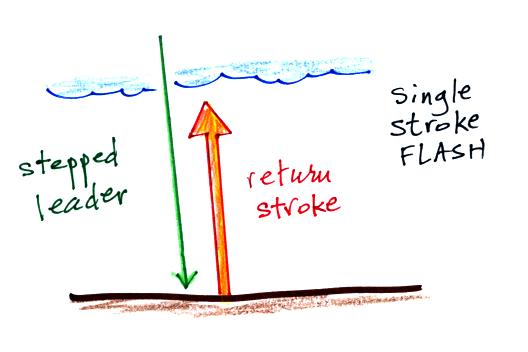
Many cloud-to-ground flashes end at
this point. In
about 50% of cloud to ground discharges,
the stepped leader-upward
discharge-return stroke sequence repeats itself (multiple times) with a
few subtle
differences.
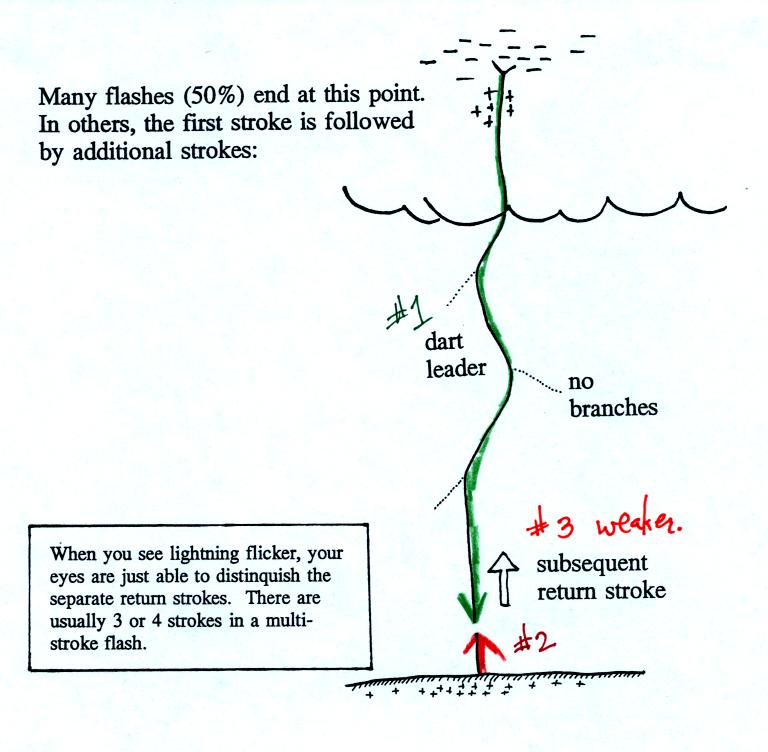

A downward dart leader travels from
the cloud to the
ground. The dart leader doesn't step but travels smoothly and follows
the channel created by the stepped leader (avoiding the
branches). It is followed by a slightly less powerful subsequent
return stroke that travels back up the channel to the cloud. This
second stroke might be followed by a third, a fourth, and so on.

A normal still photograph would
capture the
separate
return strokes
superimposed on each other. If you bumped or moved the camera
during the photograph the separate return strokes would be spread out
on the image.

The image above shows a multiple stroke flash consisting of 4 separate return strokes. There is enough time between separate return strokes (around 1/10 th second) that your eye can separate the individual flashes of light.
When lightning appears to flicker you are seeing the separate return strokes in a multiple stroke flash. The whole flash usually lasts 0.5 to 1 second.
Here's a stepped
leader-upward connecting discharge-return
stroke
animation.
We also watched a fast time resolved video of an actual stepped leader that is on YouTube
Here are some unusual types of lightning.

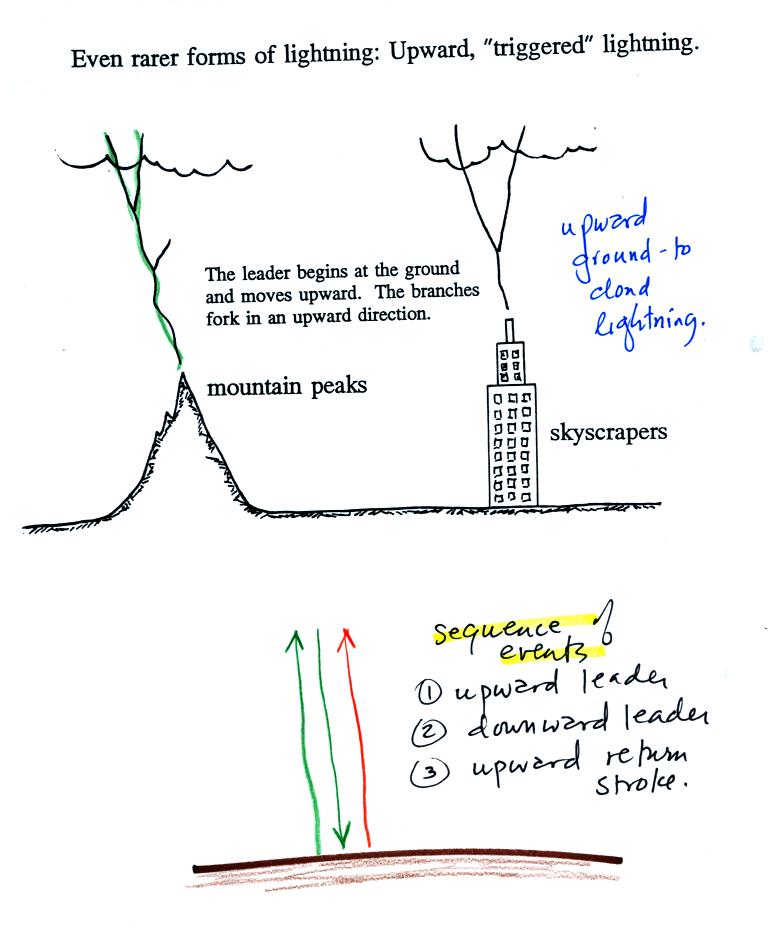
Here's an even rarer form of
lightning. Lightning
sometimes starts at the ground and travels
upward.
Upward lightning is generally only initiated by mountains and tall
objects such as a skyscraper or a tower of some kind. Note the
discharge is different in another way also. These
discharges are initiated by an upward leader. This is followed by
not by a return stroke but by a more normal downward leader. Once
the 2nd leader reaches the ground, an upward return stroke travels back
up the channel to the cloud.
Here's a slow motion video showing upward lightning.

The fact that lightning could begin
with an upward discharge that
begins at the ground lead (French) scientists to develop a technique to
trigger
lightning by firing a small
rocket up
toward a thunderstorm. The rocket is connected by a thin wire to
the ground. When the rocket gets 50 to 100 m above the ground
upward lightning will develop off of the top of the wire.
Scientists are able to take closeup photographs and make measurements of lightning currents using triggered lightning. Triggered lightning can also be used to test the operation of lightning protection devices. A short video showing rocket triggered lightning experiments being conducted in northern Florida was shown in class.
We also watched a fast time resolved video of an actual stepped leader that is on YouTube
Here are some unusual types of lightning.

Occasionally a lightning
stroke will travel from the
positive charge
region in the top of the thunderstorm cloud to ground. These
types of strikes are more common at the ends of storms and in winter
storms. This is probably because the top part of the cloud gets
pushed sideways away from the middle and bottom portions of the
cloud. Positive strokes are very powerful. They sometimes
produce an unusually loud and long lasting clap of thunder.

Here's a slow motion video showing upward lightning.

Scientists are able to take closeup photographs and make measurements of lightning currents using triggered lightning. Triggered lightning can also be used to test the operation of lightning protection devices. A short video showing rocket triggered lightning experiments being conducted in northern Florida was shown in class.

When
lightning strikes the
ground
it will often melt the soil
(especially sandy soil) and leave behind a rootlike structure called a
fulgurite. A
fulgurite is just a narrow (1/2 to 1 inch across) segment of melted
sand (glass). The video showed archaeology students excavating
around the lightning triggering site after the summer's
experiments. They were able to uncover and reveal a very long
(perhaps world record length) fulgurite.
Lightning is a serious weather hazard and kills just under 100 people every year in the United States. We discussed some lightning safety rules that you should keep in mind during thundery weather.
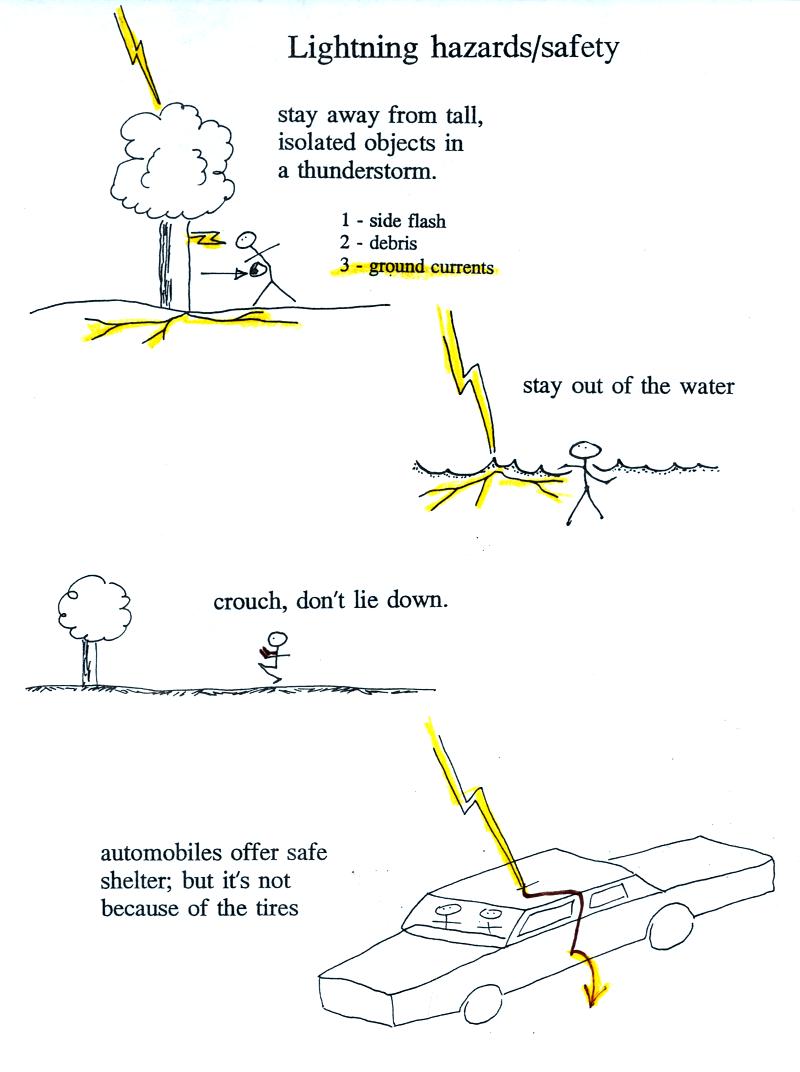
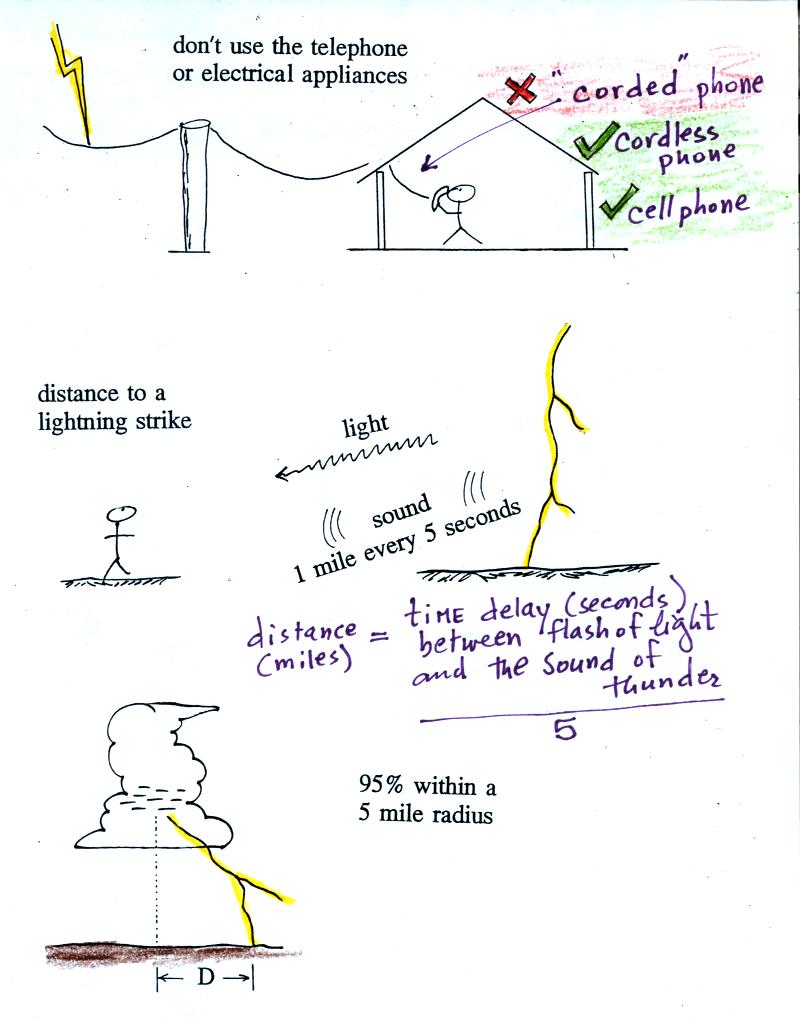
To
estimate the distance to a lightning strike
count the
number of
seconds between the flash of light and when you first hear the
thunder. Divide this by 5 to get the distance in miles.
For example, a delay of 15 seconds between the flash of light and
the sound of thunder would mean the discharge was 3 miles away.
The latest lightning safety recommendation is the 30/30 Rule.
The 30/30 rule
People should seek shelter if the delay between a lightning flash and its thunder is 30 seconds or less.
People should remain under cover until 30 minutes after the final clap of thunder.
Lightning is a serious weather hazard and kills just under 100 people every year in the United States. We discussed some lightning safety rules that you should keep in mind during thundery weather.

Stay
away
from
tall
isolated
objects
during
a
lightning
storm.
You
can be hurt or killed just by being close to a lightning strike
even if you're
not struck directly.
An
automobile
with
a
metal
roof
and body provides good
protection from
lightning. The lightning current will travel through the metal
and around the passengers inside. The rubber tires really don't
play any role at all. The people in Florida that were
triggering lightning with rockets (shown on a video last week) were
inside a metal trailer and were perfectly
safe. All of the connections made to equipment outside the
trailer were done using fiber optics, there were no metal wires
entering
or leaving the trailer.
You shouldn't use a corded phone or electrical appliances during a lightning storm because lightning currents can follow wires into your home. Cordless phones and cell phones are safe. It is also a good idea to stay away from plumbing as much as possible (don't take a shower during a lightning storm, for example). Vent pipes that are connected to the plumbing go up to the roof of the house which puts them in a perfect location to be struck.
You shouldn't use a corded phone or electrical appliances during a lightning storm because lightning currents can follow wires into your home. Cordless phones and cell phones are safe. It is also a good idea to stay away from plumbing as much as possible (don't take a shower during a lightning storm, for example). Vent pipes that are connected to the plumbing go up to the roof of the house which puts them in a perfect location to be struck.

The latest lightning safety recommendation is the 30/30 Rule.
The 30/30 rule
People should seek shelter if the delay between a lightning flash and its thunder is 30 seconds or less.
People should remain under cover until 30 minutes after the final clap of thunder.


